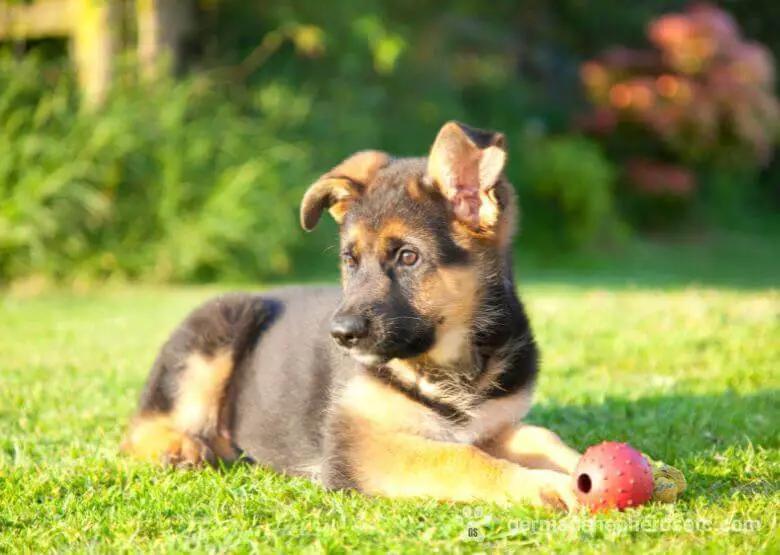Table of Contents
Little German Shepherd 8 weeks of age is very cute. Their fluffy coats, soft paws, and floppy ears are a great source of love and energy.
Your 2 month old GSD has changed a lot already during the first weeks of its life. However, many changes are going to happen soon. So, it is important to know what these changes will be and how to deal with them to let your pup grow into a healthy, strong, and intelligent dog.
Here, we have compiled the most important features and care tips you can use in your dog-raising practice.
Size and Appearance
So, your puppy is 2 months old. It is still very small, and there is not much difference in height between males and females at this age. Males grow as tall as 7-9 inches (18-23 cm), while females are 6-9 inches (15-23 cm) tall.
The 2 month old German Shepherd puppy weight changes every day. Male puppies have doubled their weight within the previous month, and now your little boy can weigh 16-20 pounds (7-9 kg). Females differ in weight a bit – your girl can weigh 11-17 pounds (5-7.5 kg).
The most prominent physical development achievement within the second month of life is getting all puppy teeth. Puppies can start adult teething soon during this period.
You can also observe the ears standing for a while, but they normally are not sturdy, so the cutie can move them up and down. When there is teething, the ears do not attempt to stand though because all the calcium in the body is used in the teething process.
The coat remains the same color and quality as during the previous month. Though you may observe a bit more shedding, and that can also be connected with teething because all the organism’s reserves are spent on it.
Activity and Behavior
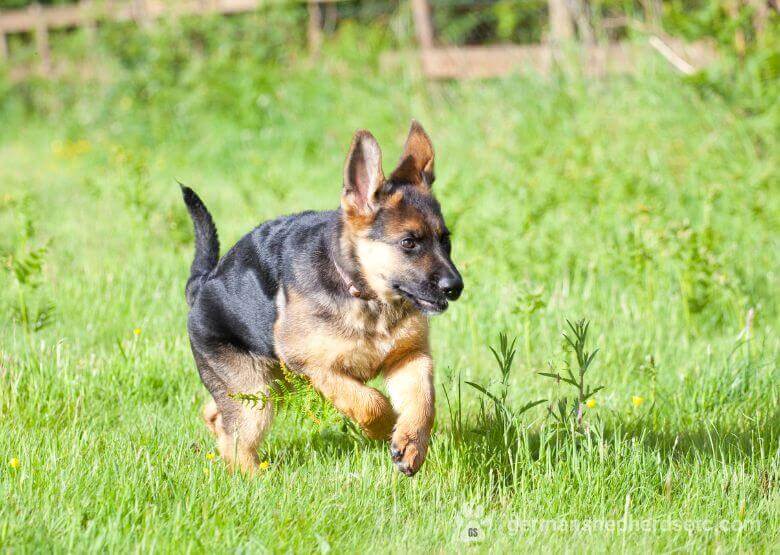
An 8 week old German Shepherd puppy is not that helpless cub it used to be a month ago. It is not completely dependent on its mother, so it’s time for it to play and explore the world. When in its litter, the puppy can play with its brothers and sister. However, if you take it home, your little one gets bored and misses its family badly. That is why it is you who should play and train it.
At this age, mental development increases, though the doggy becomes vulnerable to fears and scary situations. That is why it is important to avoid loud noises, traumatic events, and new people. The first fearful impressions may leave a trace in the dog’s entire further life and affect its temperament.
It’s time for socialization for your puppy. It gets to know how to deal with other animals and people. However, the most characteristic feature of this period is biting. Your fluffy cutie will nip and bite everything it can reach. That is why try to explain to your pet that biting your hands is a bad habit it has to get rid of. Buy several chewing toys for it instead.
A 8 week old GSD has good control of its bowel movements. It means that potty training is a must. If you have already started doing that earlier, you are unlikely to have too many accidents inside soon. In general, experts recommend the age of 7-8 weeks to start potty training.
The little Shepherd is full of liveliness and energy. It’s a good time for playing games with it. ‘Fetch’ is one of the best options. It develops the doggy both physically and mentally. Later on, your pup will play this game throughout its life.
Remember that your puppy is too young to automatically understand what to do, so you need to show it how to play. Pick out a toy or a ball that is suitable by its size for your pup. Look whether it is convenient for it to grab the toy in its mouth. The toy should be soft and easy to throw.
Choose the place for running. Big parks, beaches, or fields are OK if your doggie knows who you are, and you are sure that it will come back to you when you call it. If you are not sure, it is better to choose the fenced place for the game somewhere in your backyard.
When you throw a toy for the first time, and your pet does not know what it is expected to do further, you can demonstrate the action by going to fetch the item together. Your little German Shepherd when 2 month old is clever enough to understand what it has to do after such a demonstration.
Always praise your doggy when it fetches the toy to you. Give it some tasty treat and pat it on the back. Try not to touch the head and ears because they are too fragile at this age, so the dog may have a problem with their standing up if something goes wrong.
Health and Care
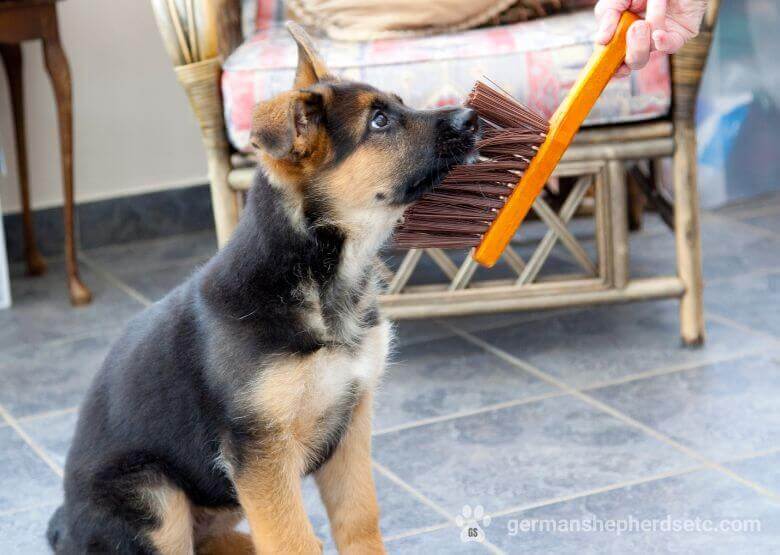
Your puppy continues growing fast during its second month of life. So, consult your vet about appropriate feeding. The healthy puppy should get its food at least 3 times per day.
It’s also the time when your puppy should be dewormed for the first time. Do this at least 10 days before the vaccination. It is also an important thing to consider at this age. The first set of vaccines includes parvovirus and distemper. The vaccines are usually administered during the 6-8th weeks of life.
You are not going to encounter any serious diseases at this age. They start after your dog gets older, at the age of over 5 years. However, you cannot exclude all genetic issues that your puppy may inherit. That’s why it is very important to do a genetic test for your dog to know what to expect in the future.
However, you should always be attentive to the health condition of your little friend. When you see something strange in its look or behavior, you should consult your vet. Among the potential signs of disease, consider the following:
- vomiting and/or diarrhea;
- urinating problems;
- excessive thirst;
- red and/or swollen gums;
- itchy and dry skin;
- refusal to eat;
- coughing;
- heavy breathing;
- runny eyes or nose;
- poor sleeping patterns;
- loss of weight, and several others.
8 weeks is the best time when a puppy can be adopted. It is not recommended to take it from its mother and littermates because it starts its socialization and gets the first experience of biting inhibition from them.
When you take your doggy home, follow the advice of your breeder and veterinarian. In addition, you need to measure and weigh your pup to be able to follow its growth. You should also think about crate training your dog from the first days of staying at your home. Don’t forget to provide it with a warm blanket for its bed or crate.
Start potty training as soon as possible. However, be very careful about the first walks. Reduce your puppy’s contact with the ground and other animals before it is vaccinated. The immune system of a little German Shepherd is too unstable and vulnerable to many infections.
How to feed a 2 Month Old German Shepherd Puppy
Your 2 month old GSD puppy is weaned from its mother feeding at this time. It has already received all the nutrients it needed during its first month. Now, it’s time to feed the puppy with other types of food. You can opt for high-quality puppy kibble or homemade food. However, you should avoid poor-quality products and cheap kibble that is full of chemicals.
If you are planning to feed your pet with kibble, it is recommended to moisten it with goat milk or fresh water if this milk is unavailable. Giving it cow milk is not recommended. Give your puppy 1.5 cups three or four times per day. Try to formulate a consistent feeding schedule with the same hours for feeding. Don’t feed the doggy before it goes to bed.
You should have two bowls for your German Shepherd. One is for food and the other for water. Your puppy needs a lot of water, so you can leave the water in the bowl to let it drink whenever it wants.
As for food, do not leave the leftovers in the bowl. Your puppy cannot control how much it wants to eat, and it can lead to overfeeding if it eats something every time it sees its bowl. You need to make the feeding schedule work. You can also give the dog some puppy treats, but the number of calories they contain should not exceed 10% of all the food.
However, do not feed the puppy two times per day. It is too young for that, so it can overeat too and have severe digestion problems. Don’t forget to take your puppy outside for its potty 10-15 minutes after feeding to avoid accidents.
How to Train a 2 Month Old German Shepherd
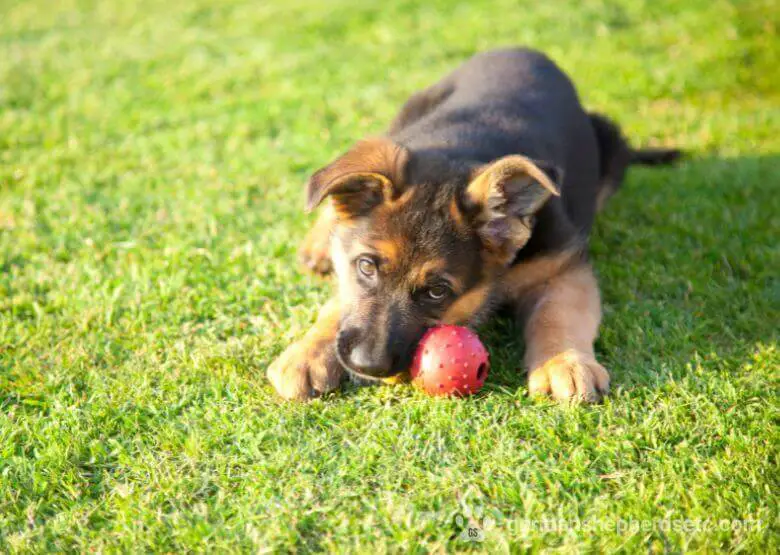
When you get a 2 month old GSD, it’s the best time to start its training. You should teach it to recognize the connections between commands and responses or responses and consequences.
Foremost, you need to set primary anchors. It means that you should develop certain reactions to your actions to teach the puppy to follow you, eat food or receive treats, and sit. Your clapping hands, whistling, or a specific word can be such anchors. Avoid setting anchors that your puppy will feel as similar. For example, at this age, it will not distinguish between ‘sit’ and ‘run’.
The next training step is establishing authority. Your puppy should understand that you are its guide, and it will help you when you start training more complex commands. Your little pet should understand that you are its pack leader. So, the first thing to teach is to follow you. Praise the puppy if it does everything correctly, and never punish it if it does not understand you.
Early socialization training is also very important. However, early exposure of your pet to many people and unfamiliar things may lead to psychological problems. That is why start socializing your puppy gradually. You can take it on short visits to your family or friends. Remember that it cannot walk long distances, so don’t let it get tired all the time when it is outdoors. Keep socializing your doggy every day but in small portions of positive experiences.
Start potty training as soon as you bring your GS puppy home. Show it where you want it to do its business, in the backyard or garden. Ensure that this area is quiet and fenced. It has to be something soft like grass or mat. Establish an exact schedule for going potty. Taking the puppy outside is the first thing you need to do after it wakes up in the morning. Then, follow the schedule after each meal, playing, and before going to bed.
Keep the puppy out of biting and nipping. You should not beat or punish it anyway. Though, teach the puppy to avoid severe bites on the hands and legs. You can arrange timeouts for it if it bites too harshly. For example, if it bites your hand while taking a treat, withhold the next treat until it understands how to take it gently. If it bites you when you are watching TV or sitting still, make an abrupt shout, something like ‘Ouch!’ to let it know that its behavior is wrong. Reward it with a treat when you see that the little one understands what you want of it and denies biting at all. German Shepherds are very clever, so they understand the explanations very quickly. You won’t experience the puppy biting you in a while.
Be patient while training your little dog. It will be trained enough to understand how to control itself by the 10th week.
FAQ
How big is a 2 month old German Shepherd?
Your puppy at this age is relatively not too big, and you won’t see any significant differences in height between males and females. Therefore, your boy will grow as tall as 7-9 inches (18-23 cm), while the little girl will be 6-9 inches (15-23 cm) tall.
How much does a 2 month old German Shepherd weight?
GS puppies gain weight at this age very quickly. They tend to double it in comparison to the first month. Your male doggy will approximately weigh 16-20 pounds (7-9 kg). If you have a female puppy, its weight will be smaller – 11-17 pounds (5-7.5 kg).
How much to feed a 2 month old German Shepherd puppy?
You can give your puppy 1-1.5 cups of puppy kibble soaked in goat milk 3-4 times per day. You can also give it tasty treats, but don’t do it too often. The overall number of calories from treats should not exceed 10% of all puppy food.
How often should I feed my 2 month old German Shepherd?
You should feed your pup 3-4 times per day. Never make a feeding schedule of 2 times per day because your doggy can overeat and have digestive problems.
How much exercise does a 2 month old German Shepherd puppy need?
Little GS puppies are very energetic, so they need a lot of exercises. However, they are too young for hard exercise and training. Play ‘Fetch’ or some other games with it. The sessions can be very short (about 10-15 minutes or less) and not too intensive.
Can I walk my 2 month old German Shepherd?
Yes, you can walk your puppy in the backyard or any other fenced space after it is vaccinated. Though remember that your little doggy cannot go on long walks yet, so never make its walks too long. 10-15 minutes 4 times per day is pretty enough. Another thing to consider is that it cannot follow you yet, so try to avoid going for walks in the open spaces and streets, or your pup can get lost.
Final Thoughts
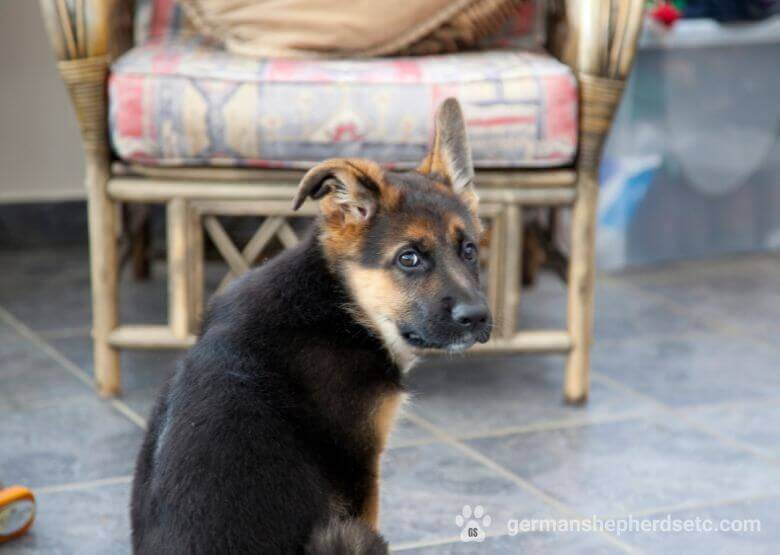
Remember that you take responsibility when you bring your 2 month old GSD puppy home. Learn a lot about the breed before you decide to adopt this dog. You also need to know that your pup will have enough space for its activity and energetic behavior. You also need to consider your budget. German Shepherd puppies can cost $400-$2,000 when you buy them from a reputable breeder.
Get prepared that your doggy will bark, whale, bite and chew everything around. However, you will also get a lot of joy, playing, laughing, and loyalty. German Shepherds are very intelligent, and you will get the best friend for many years if you are patient and consistent enough during its first days at your home.
